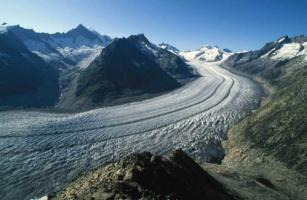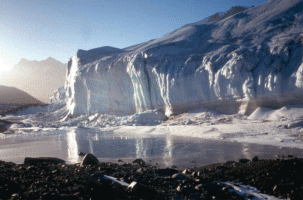 SKC Films Library |
| SKC Films Library >> Geography >> Physical Geography >> Ice, Glaciers, Ice Sheets, Sea Ice |
| Glaciers in General A glacier is a huge mass of ice up to 10,000 feet thick that flows slowly over land. All glaciers begin to form when more snow falls during the winter than melts and evaporates in summer. The excess snow gradually builds up in layers. Its increasing weight causes the snow crystals under the surface to become compact, grainlike pellets. At depths of 50 feet or more, the pellets are further compressed into dense crystals of ice, which combine to form glacial ice. This ice eventually becomes so thick that it begins to move under the pressure of its own great weight. The ice crystals deep within the glacier glide over one another as a result of the pressure of the surface layers, and these small movements of individual crystals cause the entire ice mass to move. The melting and refreezing of the ice crystals along the base of a glacier help it slide downslope. Heat from friction and from the earth's interior melts some of the crystals of the glacier's bottom layer. The water from the dissolved crystals flows down into nearby open spaces in the layer and refreezes, forming new ice crystals. Valley glaciers are long, narrow bodies of ice that fill high mountain valleys. Many of them move down sloping valleys from bowl-shaped hollows located among the peaks. In mountains near the equator, such as the northern Andes of South America, valley glaciers occur at elevations of about 15,000 feet or higher. Valley glaciers occur at lower elevations in the European Alps, the Southern Alps of New Zealand, and other mountain ranges nearer the poles. A valley glacier may move less than a foot a day, or more than a hundred. Some valley glaciers go through "growth spurts" and will surge forward several hundred feet at one time and then seem to stop all together. Continental glaciers are broad, extremely thick ice sheets that cover vast areas of land near the earth's polar regions. Greenland and Antarctica are both covered by huge continental glaciers. These glaciers build up at the center and slope outward toward the sea in all directions. A continental glacier tends to move slower than a valley glacier, but may move quite a bit faster at some places than others. continental glacier in Greenland Glacial Terms Arete a steep-sided, sharp-edged ridge formed by two glaciers eroding away opposite sides of the ridge. Cirque an amphitheater-shaped feature created when the upper part ("headwaters") of a glacier removes blocks of rock from the surrounding cliffs. Cirque Glacier a small glacier occupying a cirque but which does not extend down-valley from the cirque. Col a low spot along a cirque or an arete. Crevasse a crack in the glacial ice. Drumlin an oval-shaped hill that usually consists of rock debris. End Moraine an accumulation of unconsolidated material deposited at the snout end of a glacier. Esker a long, narrow ridge of sand and gravel deposited by a stream of water that flowed in a tunnel beneath a melting glacier. Ground Moraine unconsolidated material deposited directly beneath the base of a glacier. Headwall the steep back-wall of a cirque. Horn a pyramid-shaped mountain peak created by several glaciers eroding away at different sides of the same mountain. Ice Fall the glacial equivalent of a waterfall. Lateral Moraine unconsolidated material deposited along the sides of a valley glacier. Medial Moraine a moraine formed on top and in the middle of an existing glacier where two valley glaciers flow together. Moraine an accumulation of unconsolidated material deposited by glaciers. Ogives alternating bands of light and dark ice formed at the base of some ice falls. Paternoster Lakes a chain of lakes in a glacial valley. Recessional Morraine an accumulation of unconsolidated material deposited when a glacier pauses during periods of retreat. Roches Moutonnées broad humps of hard bedrock left behind as a glacier decreases in size. Tarn a glacial lake produced by scouring. Terminal Moraine an accumulation of unconsolidated material that marks the farthest extent of glacial advance. Truncated Spur a drainage divide that has been cut off as glaciers straighten the valleys they erode. Some Basic Facts About Glaciers About 75% of the world's total supply of fresh water is stored in glaciers. If all the glaciers of the world melted at once the seas would rise about 230 feet. The longest glacier in North America is the Bering Glacier in Alaska, measuring almost 127 miles in length. Glacial ice can be very old. In some Canadian Arctic icecaps, ice at the base is over 100,000 years old. The Kutiah Glacier in Pakistan holds the record for the fastest glacial surge. In 1953, it "raced" more than 7 miles in 3 months, averaging about 367 feet per day. Glacial ice often appears blue. SOURCE SEE ALSO |
| SKC Films Library >> Geography >> Physical Geography
>> Ice,
Glaciers, Ice Sheets, Sea Ice This page was last updated on 12/16/2017. |

